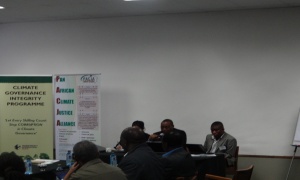Day 1: Climate Finance Governance Effectiveness in Africa
Talk of the ravaging effects of climate change, and Africa comes into mind: frequent droughts, floods, landslides as well as recurrent conflicts over Africa. In essence, this has been the center of the climate change debate, with due regard to who is responsible for human-induced climate change, the degree of responsibility as well as the mode and degree of intervention to alleviate this challenge. It is in this context that actors in climate finance governance are meeting in Johannesburg to explore these issues, under the auspices of the “Ensuring Climate Finance Effectiveness in Africa”, in Johannesburg, South Africa, from 21-23May 2013. This workshop has been organized by the Heinrich Boll Foundation (HBF), Transparency International Kenya and Pan African Climate Justice Alliance (PACJA).
Climate Finance Space in Africa
The first day of the workshop featured presentations capturing different spheres of climate finance in Africa. Of paramount importance were the issues of governance, transparency and accountability, upon which the effectiveness of climate finance governance in Africa. Also, the participation of different players in the climate finance governance domain in Africa was explored, as well as the methodologies that should be embedded in climate finance mechanisms so as to realize climate finance effectiveness, especially with regard to budget tracking.
Climate finance governance
The issue of governance, which is the crux of this workshop, was well elaborated on by the opening remarks made by Transparency International Kenya’s Executive Director, Samuel Kimeu, and this set the context for subsequent deliberations. Some of the challenges besetting climate finance governance in Africa were identified as:
Corruption: Mr. Kimeu singled out corruption as the biggest challenge facing climate finance governance in Africa. This was manifested through lack of transparency, participation as well as monitoring and tracking mechanisms in climate finance management. A case in point: Kenya loses about 30% of its development budget to procurement malpractice!
Policy Capture: The risk of policy capture, whereby some authorities hijack policies to achieve undue influence, was identified as a major issue jeopardizing climate finance governance.
Creative Accounting and reporting: The issue of creative accounting was also put on the crosshairs as many donors were counting aid as part of climate finance. For example, the Fast Start Finance agreed upon at COP15, as captured in the Copenhagen Accord, was mainly disbursed as loans, with only 43% of the funds being grants.
“You cannot burn my house and give me a loan to rebuild it” – remark from a participant
Lack of participation: the people at the center of the discussion on climate finance governance are the groups most vulnerable to climate change, and they are seldom brought into this discourse. This is a sad reality, and it was agreed upon that it was critical to involve all parties in order to realize climate finance governance.
Bureaucracy: Accessing climate finance, especially from the multilateral funds such as the Adaptation Fund, is a major headache for many countries in Africa. This is due to the sheer bureaucracy involved in accessing these funds, as well as the technical capacity required in preparing applications to be an implementing entity. For example, there are only 5 National Implementing Entities (NIEs).
Lack of capacity: most African countries that need climate finance are unable to access it due lack of sufficient technical capacity required to prepare applications to be National Implementing Entities (NIEs), as is in the case of applying for funds under the Adaptation Fund. For example, Zambia had their application to an NIE turned down because they fronted the Ministry of Finance as the entity, and they were duly informed that this was not a viable entity.
Conclusion
With the context already set, we will explore the Global Climate Finance architecture in the next post.


